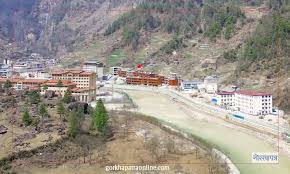KATHMANDU: Most of the trade points, including Kimathang, which is located at Sankhuwasabha border with China, are starting to operate again from Saturday.
The border crossing, which was closed by the Chinese government due to the covid epidemic, is going to be re-opened after four years of negotiations, dialogue and agreement between the high political leaders of Nepal and China.
Due to the fear of the spread of Covid-19, the Chinese government closed 14 traditional border trade points in the northern region, including Kimathangka. The two countries had been continuously discussing through diplomatic channels for the re-operation of the traditional border. On the occasion of Foreign Minister Narayankaji Shrestha’s official visit to China last March, an agreement was reached to gradually open all the traditional trade channels in the border area.
Rasuwagadhi-Kerung, Tatopani-Jhangmu, Yari-Puran and Nechung-Lichi (Korla) trade points have already been operational. Taplejung’s Tiptala crossing has also resumed operations from Friday.
A delegation of high-ranking officials including Koshi Chief Minister Hikmat Kumar Karki, Joint Secretary of the Ministry of Home Affairs and Foreign Affairs, Chief District Officer, Chief of the District Security Agency is going to Kimathang on Saturday to participate in the opening ceremony of the re-operation of all 14 trade points on the Nepal-China border including Kimathang.
Minister Shrestha and the vice president of China’s Tibet Autonomous Region, Silang Nima, are scheduled to announce the re-operation of the entire trade route including Kimathangka-Chentang during a ceremony. Dhruv Bahadur Khadka, the Chief District Officer of Sankhuwa Sabha, said that all 14 trade points on the Nepal-China border will be announced here.
According to the Ministry of Foreign Affairs, the Chinese side has informed that it will open seven different border crossings and other border crossings will be opened within a certain time. Border crossings with Darchula, Dolpa, Mustang, Gorkha, Dolakha, Taplejung and Sankhuwasabha districts will be opened from Saturday.
With the opening of all the trade channels in the northern region, there will be presence of the state in the border region, increase in customs revenue, sale of local products and employment creation. “Currently, customs revenue is being collected only from the limited border crossings of the northern border, and with the opening of the border, it will contribute to the customs revenue”, said Prajia Khadka of Sankhuwasabha, “The traditional handicraft materials produced in the Himalayan region can enter the Chinese market easily.”
Khadka said that with the opening of the borders, there will be changes in the living standards of the people in the high Himalayan region. “Jobs in the northern region were stopped due to non-operation of the border,” he said.


Comments are closed.